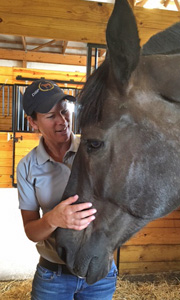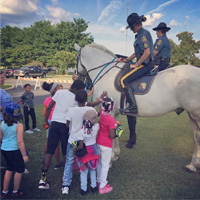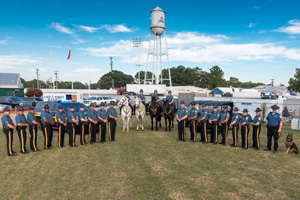By: Samantha Facciolo
 The unassuming, blue and white structure off Smyrna Landing Road is bordered on one side by the Central Violation of Probation Center and by the James T. Vaughn Correctional Center on another. A quiet, two-lane road runs in front of the property, separating it from the cornfields stretching into the distance. Here, on eight acres donated by the Department of Corrections, the six horses of the Delaware State Police Mounted Patrol live and train.
The unassuming, blue and white structure off Smyrna Landing Road is bordered on one side by the Central Violation of Probation Center and by the James T. Vaughn Correctional Center on another. A quiet, two-lane road runs in front of the property, separating it from the cornfields stretching into the distance. Here, on eight acres donated by the Department of Corrections, the six horses of the Delaware State Police Mounted Patrol live and train.
Thanks to the hard work of Master Corporal Alison Meadows, the horses and their lodgings are immaculate. The aisle is swept clean, the stalls are freshly bedded and not a buckle or strap in the tack room is out of place. Whether it’s police instinct or equine habit, discipline and attention to detail are evident in every facet of these horses’ care. The donated Percheron and Shire horses stabled here are the heart of this facility and as such, are treated accordingly. Though on the morning I visit, they’re dozing or munching hay in their stalls, happy for a head scratch or a pat on the nose, these horses and their riders, veteran State Troopers, are well trained in all aspects of mounted duty.
In 2012, when Master Corporal Alison Meadows launched the state’s mounted patrol, she was operating it as a part-time unit forged from the cooperation of several organizations, including the Department of Corrections, the Department of Agriculture, New Castle and Kent Counties and donations from multiple individuals. A lifelong horsewoman, Meadows reached out to several established units, including the NYPD and mounted patrols in New Castle County, Pennsylvania, Florida, and California for guidance and training. The fledgling unit, which at the time included an off the track Thoroughbred, had its first patrol on Memorial Day weekend in Dewey, not exactly the calmest of places. However, the horses were champs, and the mounted patrol was born.
Today, only a few years later, the unit is thriving. In addition to its six four-legged stars, four women and eight men make up the patrol. Each was a state trooper for a minimum of three years before undergoing basic training to join the special unit. Troopers do not need to have prior equine experience, but they need to be willing to learn. And in some cases, that instruction can come from unusual places. Like from inmates living next door.
One of the Delaware State patrol’s biggest successes has been its partnership with inmates preparing to leave the Vaughn Correctional Center. When we spoke, one of the first things Alison detailed was the team approach and work ethic utilized in the rehabilitation program. Five days a week, selected inmates come to the barn on work release.  Under the guidance of a corrections officer they feed, muck stalls, complete basic stable care, and learn to care for the unit’s horses. Through their time in the program, they often develop a niche, such as trailer maintenance, assisting the vet or farrier or carpentry. These skills, with their emphasis on hard work and community involvement, combined with a letter of support signed by Master Corporal Meadows, assist these offenders as they prepare to re-enter the general population.
Under the guidance of a corrections officer they feed, muck stalls, complete basic stable care, and learn to care for the unit’s horses. Through their time in the program, they often develop a niche, such as trailer maintenance, assisting the vet or farrier or carpentry. These skills, with their emphasis on hard work and community involvement, combined with a letter of support signed by Master Corporal Meadows, assist these offenders as they prepare to re-enter the general population.
Throughout my visit, teamwork was one of the key threads running through the patrol. After undergoing the ten-day basic mounted course, accepted state troopers complete a three-month field-training program designed to further immerse them in the unit’s work and in the human-equine bond. The troopers each work with two horses, spending time developing trust and a working partnership. Horses, Alison explains, are a fight or flight animal, with flight being their first choice. Therefore, they have to be trained to trust their riders, especially in strange and unfamiliar situations. “We train for trust,” Alison says.
 What exactly does a police horse need to be able do to? In addition to everyday riding skills, these horses undergo extensive sensory training that includes exposure to a firing range, police dogs, fire engines, helicopters and other stimuli. The horses are in the public eye five to seven days a week, working patrols, performing training exercises and putting on demonstrations for the public. They assist in arrests, terrain searches, crowd control and more. In addition, they do what Alison calls “humanizing the badge.” The horses allow officers face-to-face contact with the communities they serve. They patrol neighborhoods and events such as the Delaware State Fair, Point to Point, and concert venues. They visit schools and business districts and pique people’s curiosity. Everyone’s interested in these giants and often, people who initially approach because they want to pet a horse end up having a conversation with the officers. Over time, the horses become “a tool on [the officer’s] duty belt,” and a relied-upon resource for the force. The rider must trust the horse and the horse the rider. In time, as Master Corporal Meadows and her unit have demonstrated, it’s that very partnership that leads to success.
What exactly does a police horse need to be able do to? In addition to everyday riding skills, these horses undergo extensive sensory training that includes exposure to a firing range, police dogs, fire engines, helicopters and other stimuli. The horses are in the public eye five to seven days a week, working patrols, performing training exercises and putting on demonstrations for the public. They assist in arrests, terrain searches, crowd control and more. In addition, they do what Alison calls “humanizing the badge.” The horses allow officers face-to-face contact with the communities they serve. They patrol neighborhoods and events such as the Delaware State Fair, Point to Point, and concert venues. They visit schools and business districts and pique people’s curiosity. Everyone’s interested in these giants and often, people who initially approach because they want to pet a horse end up having a conversation with the officers. Over time, the horses become “a tool on [the officer’s] duty belt,” and a relied-upon resource for the force. The rider must trust the horse and the horse the rider. In time, as Master Corporal Meadows and her unit have demonstrated, it’s that very partnership that leads to success.










